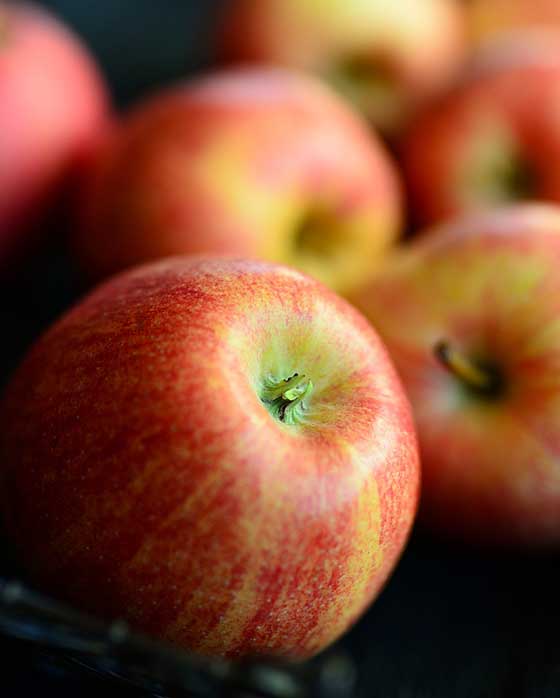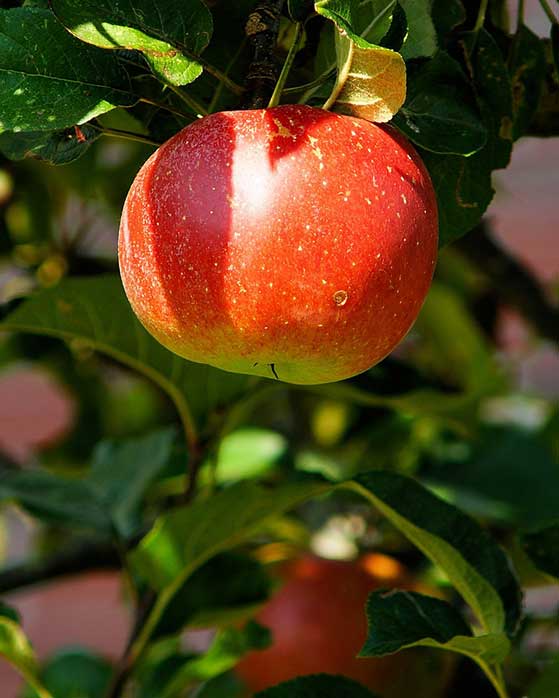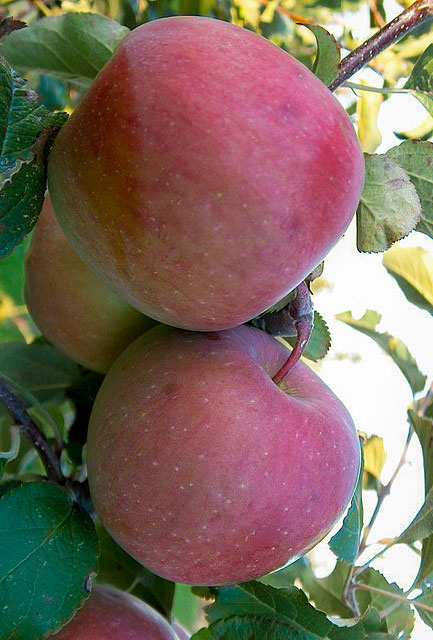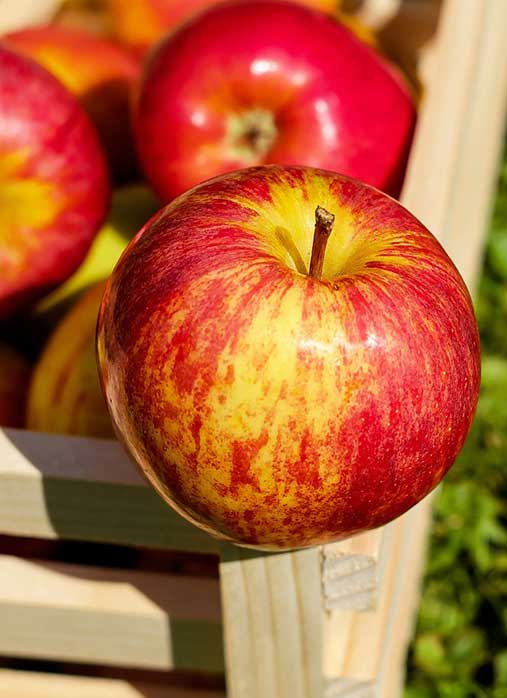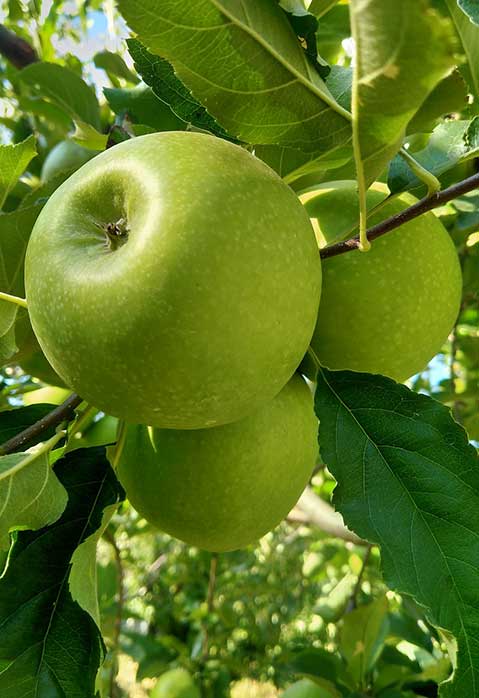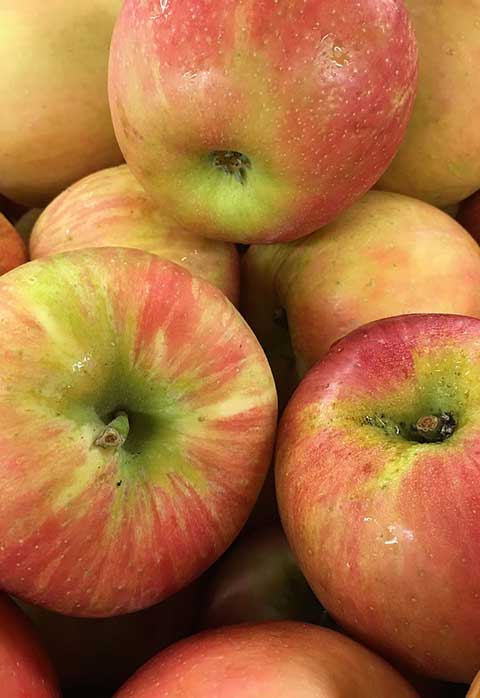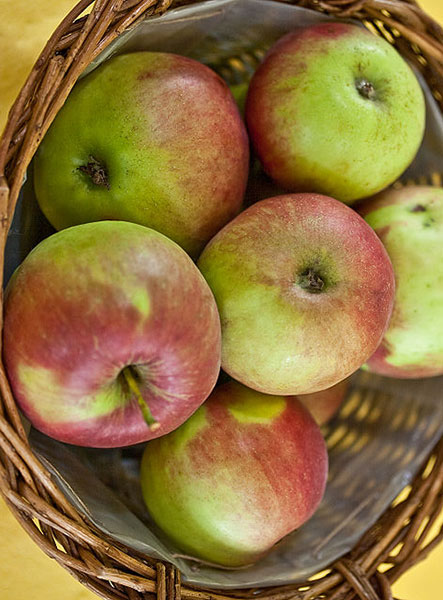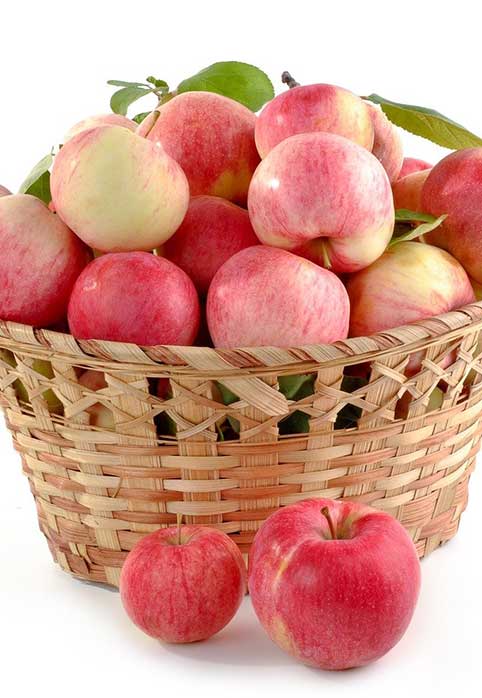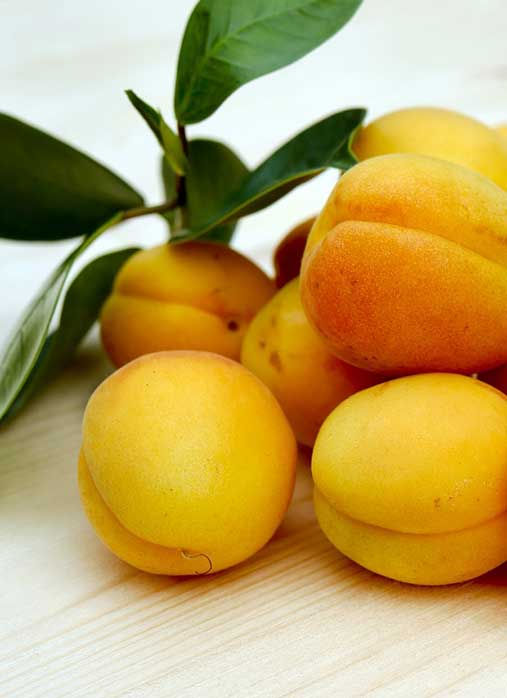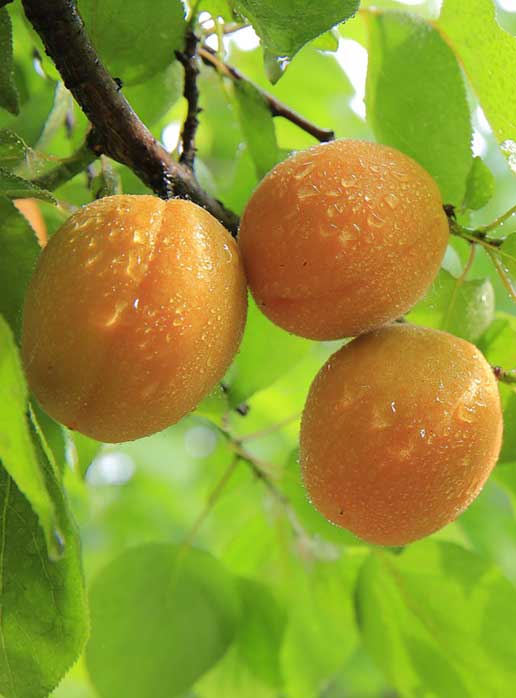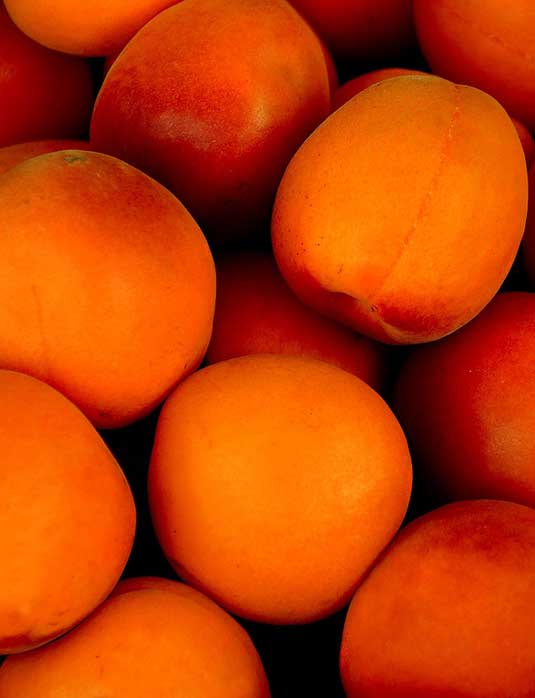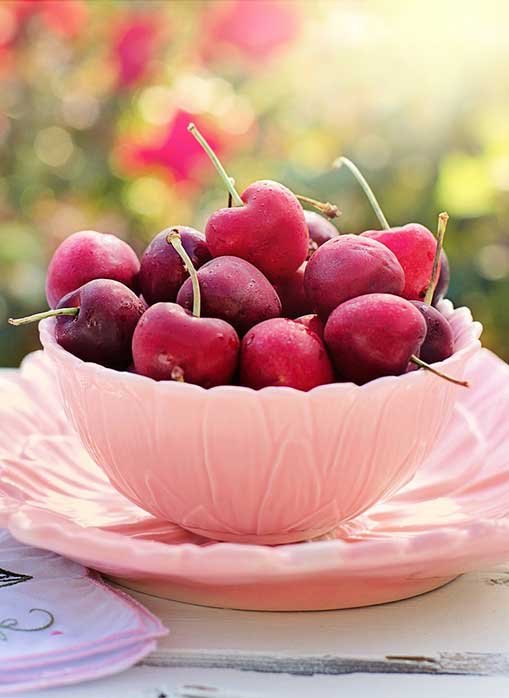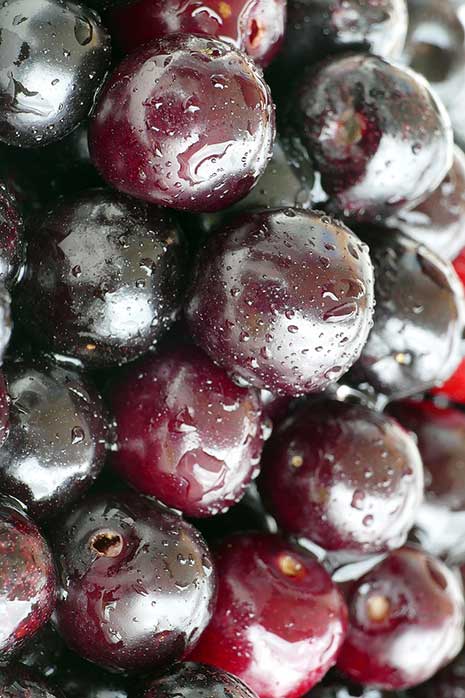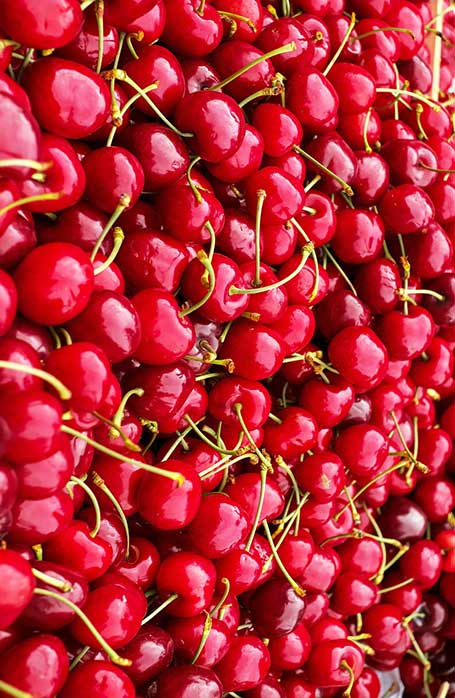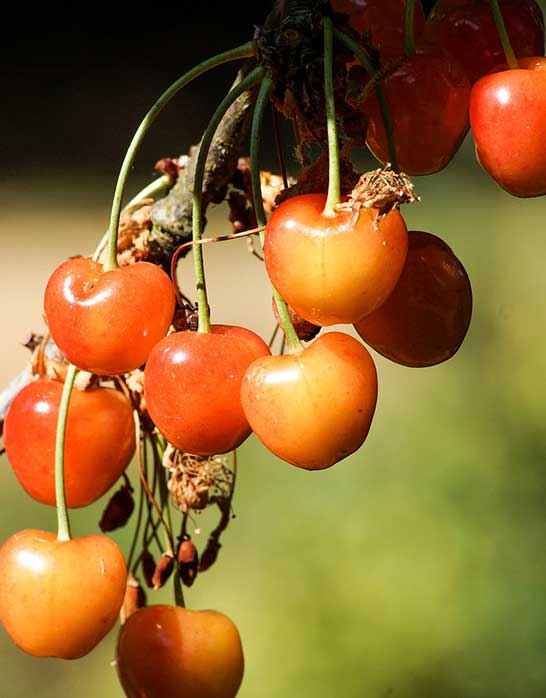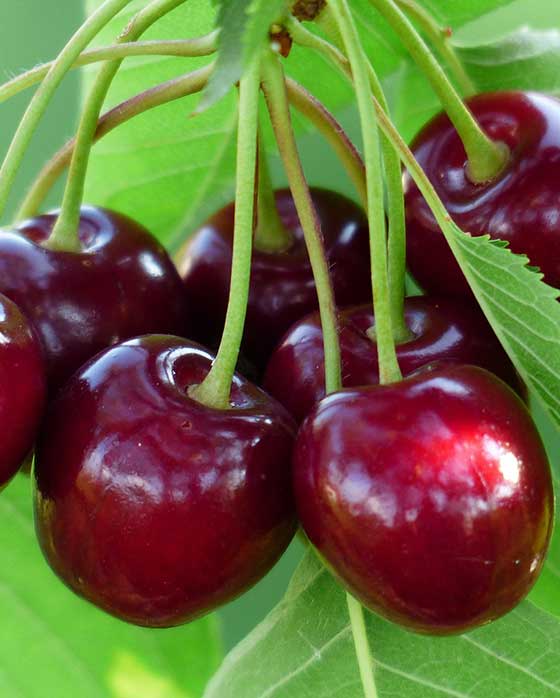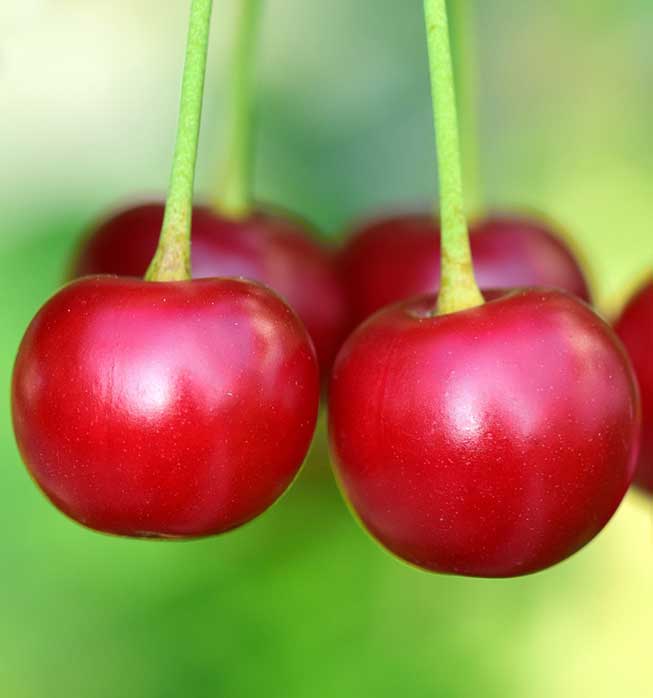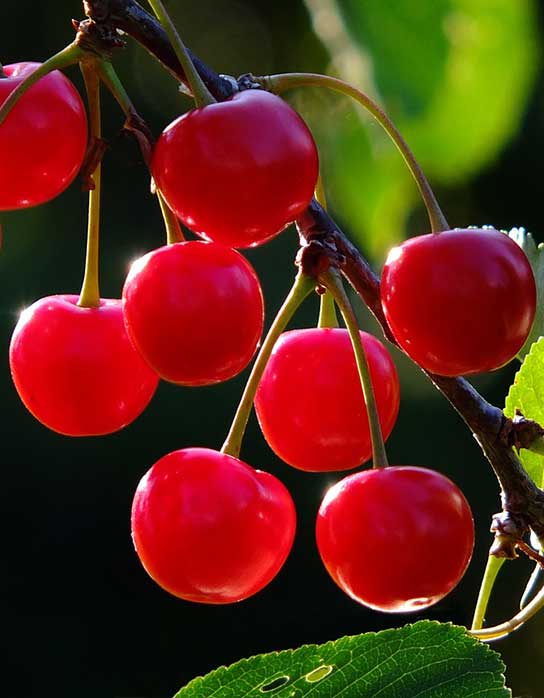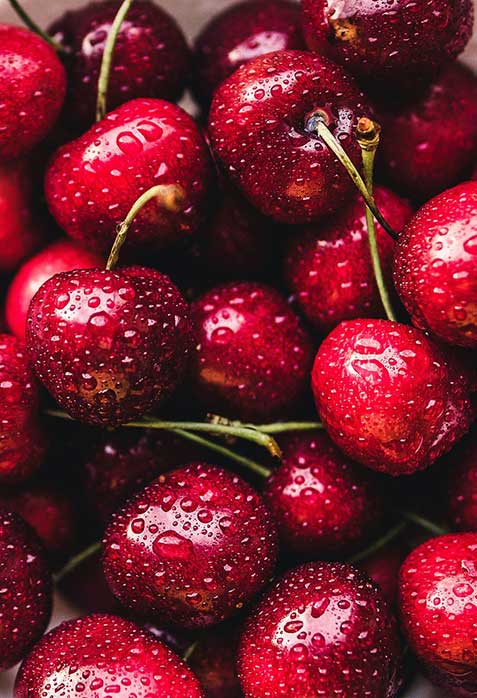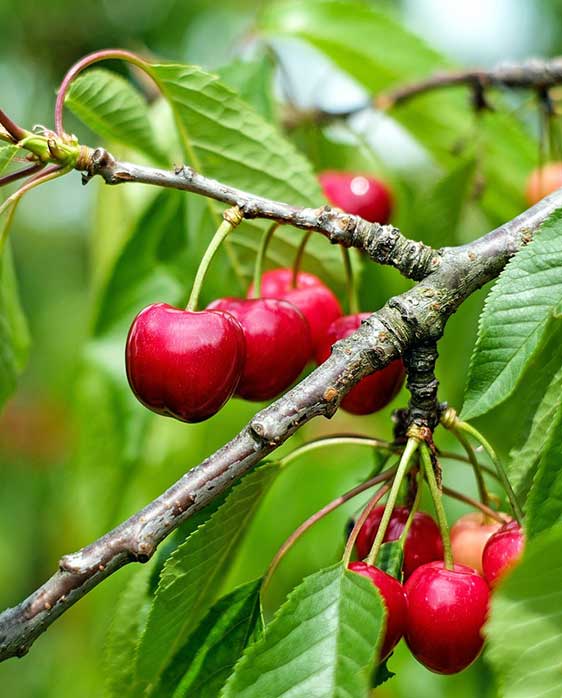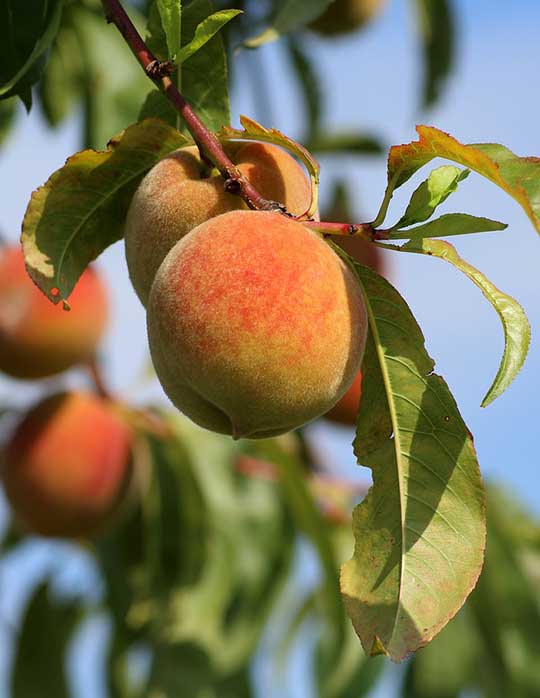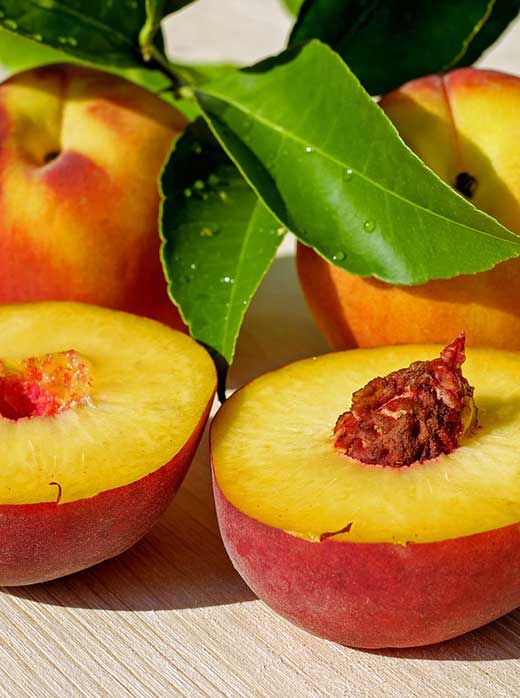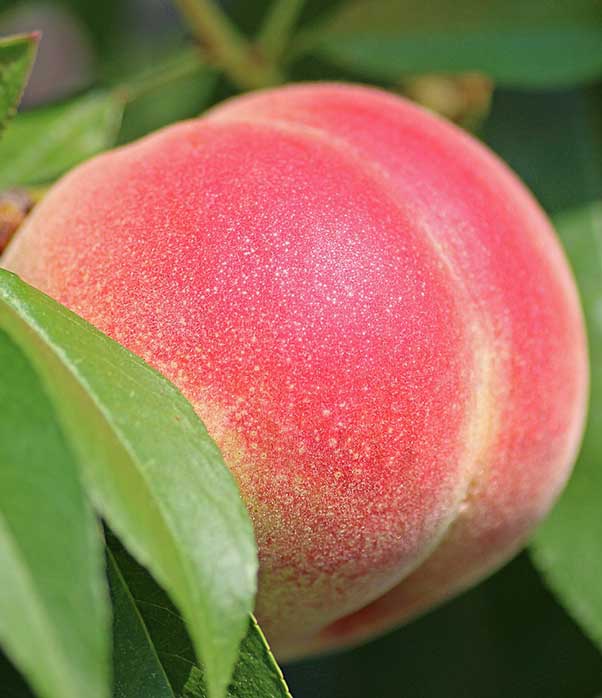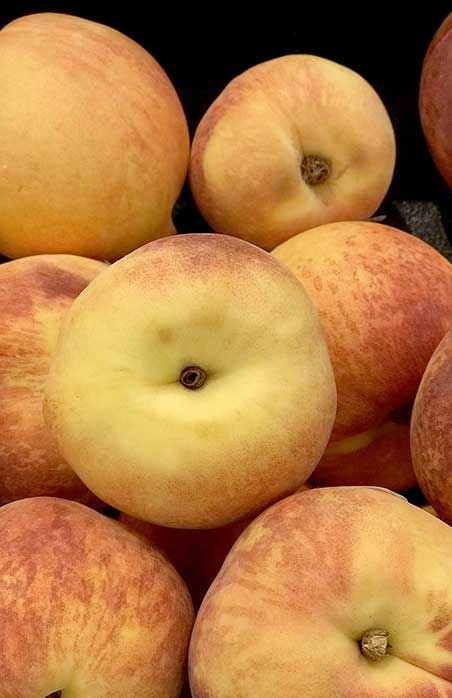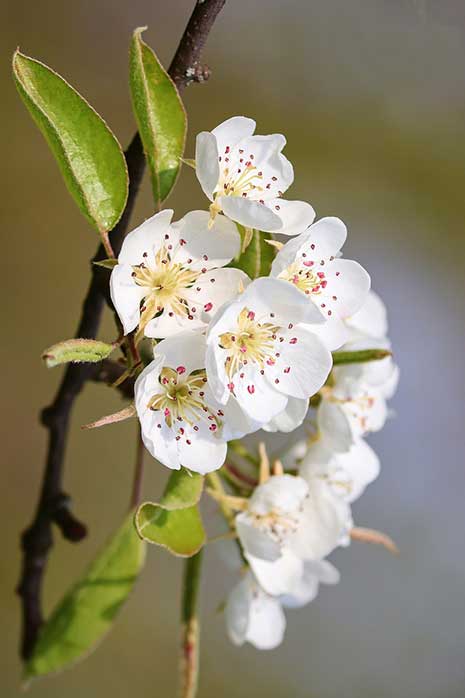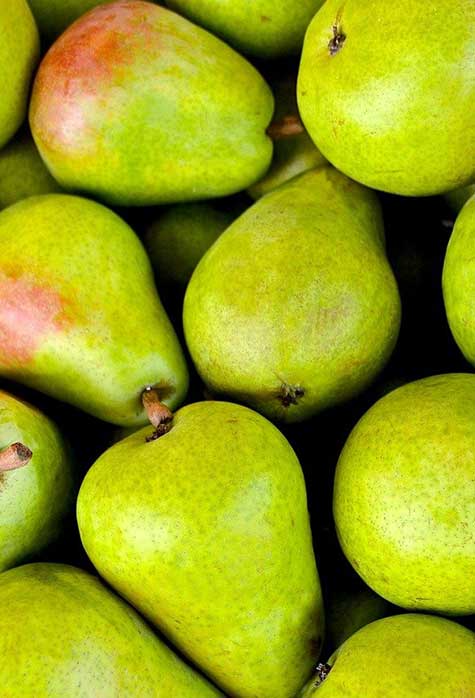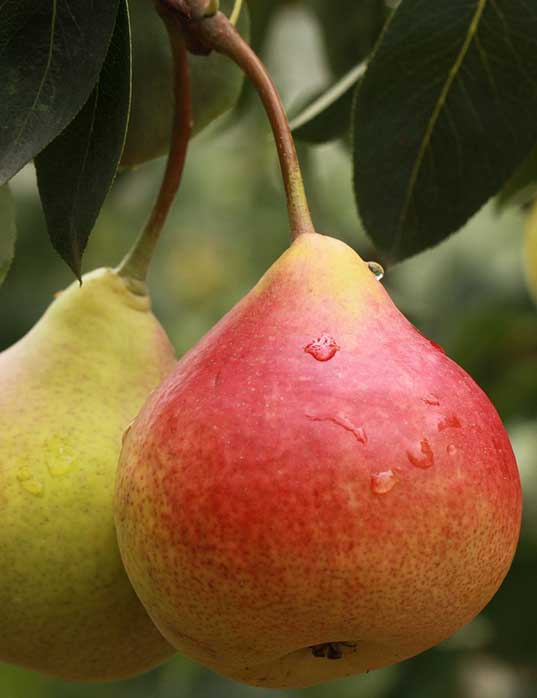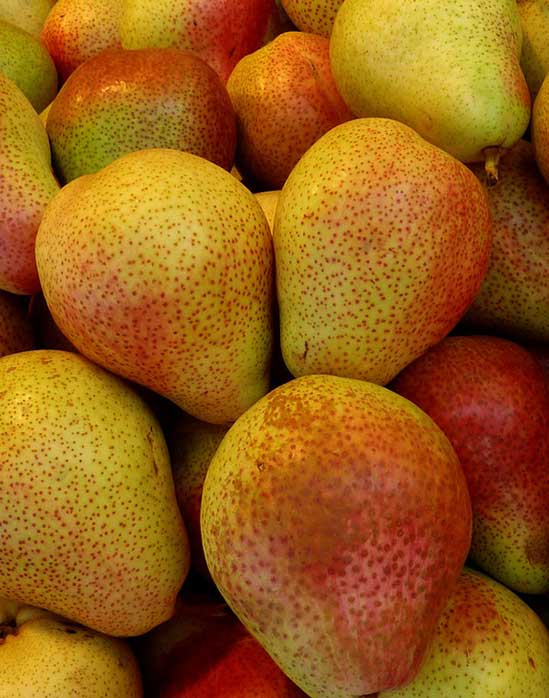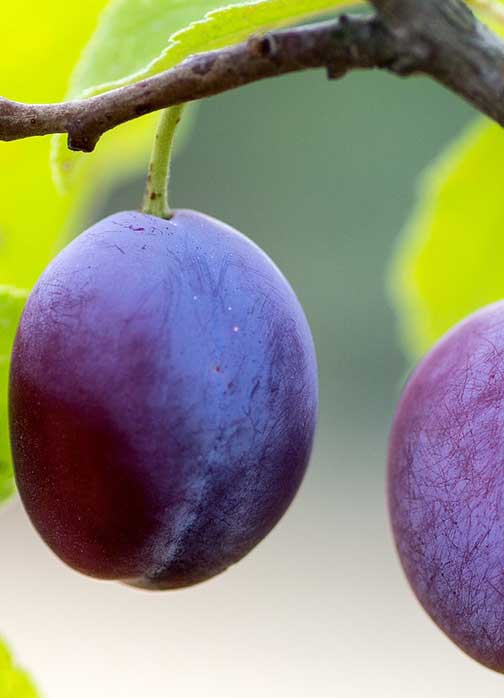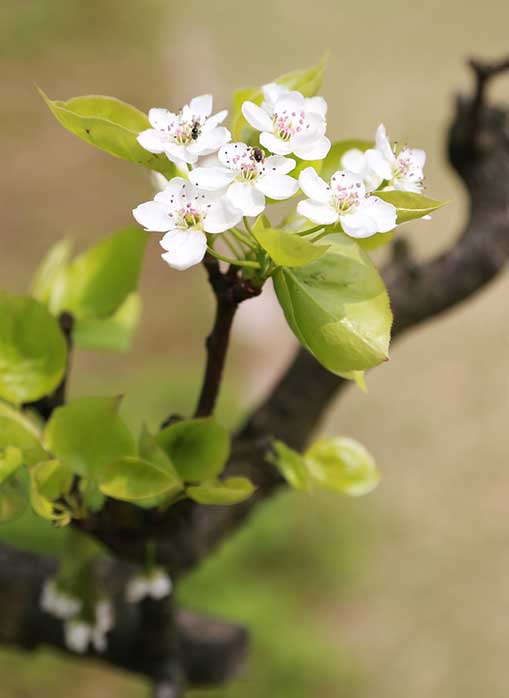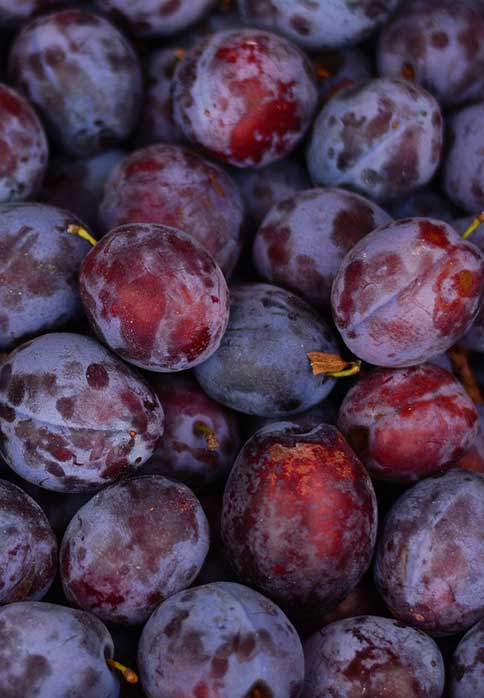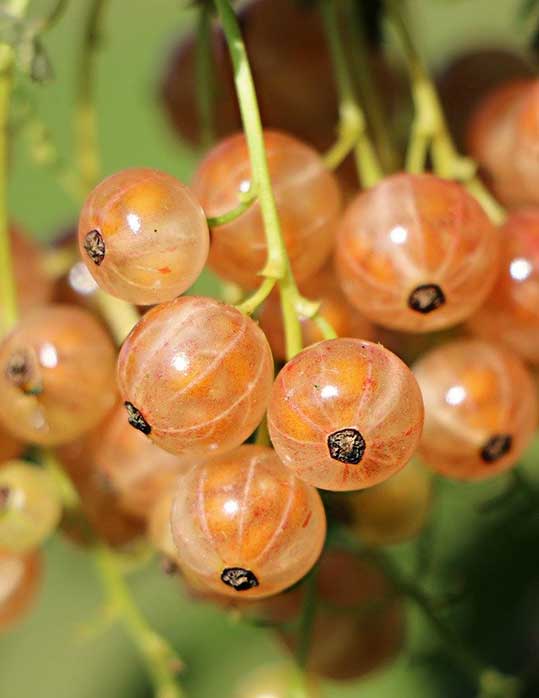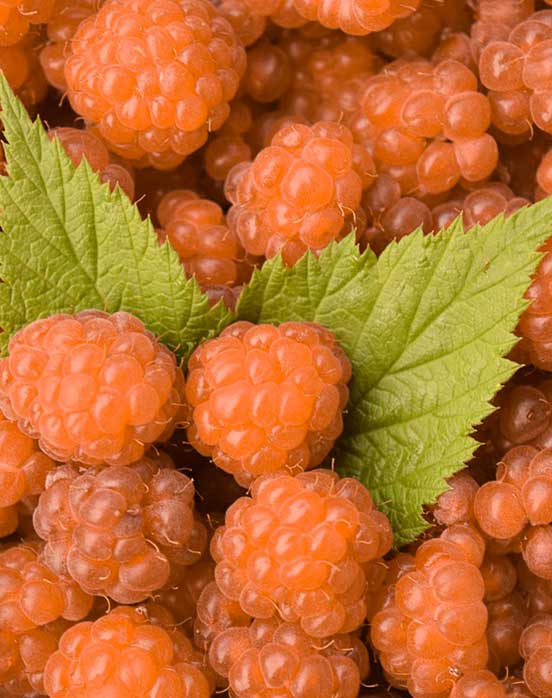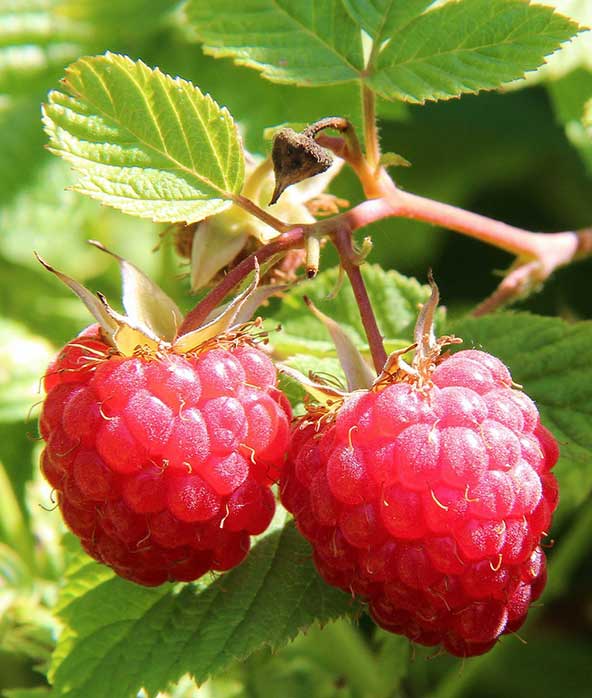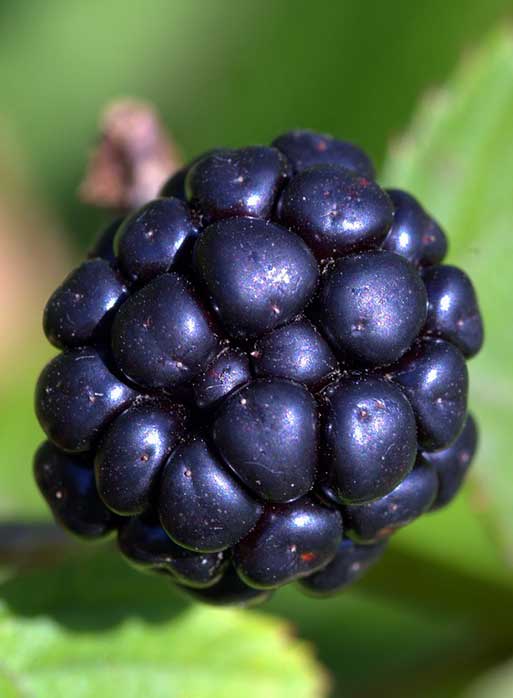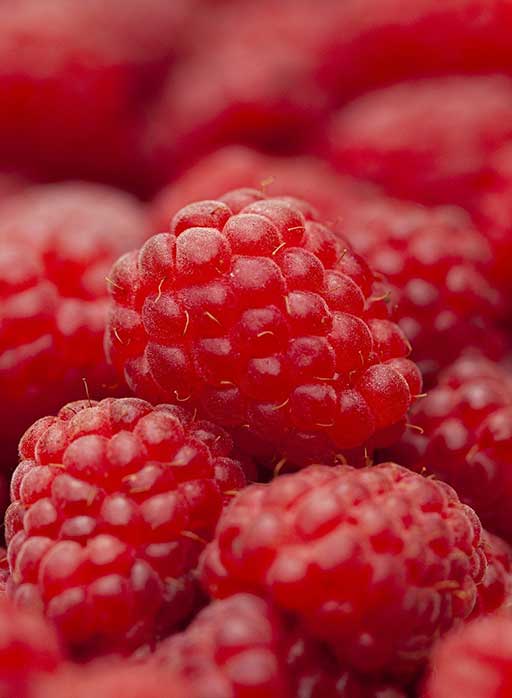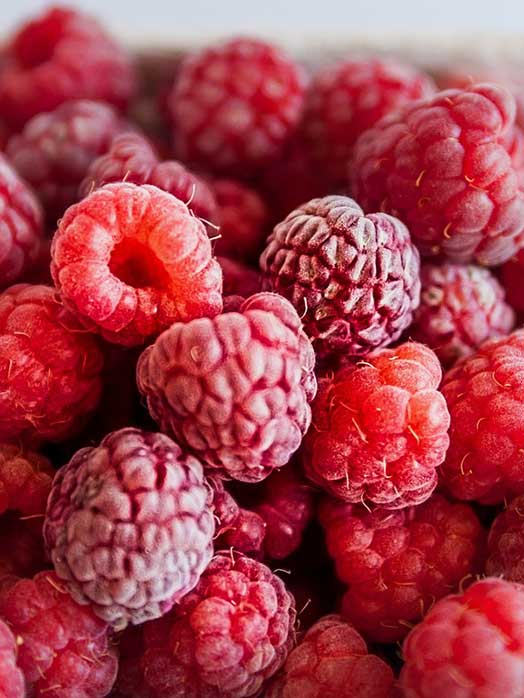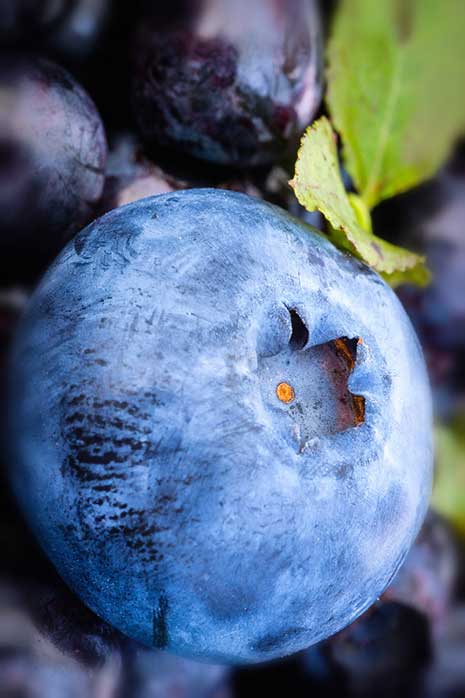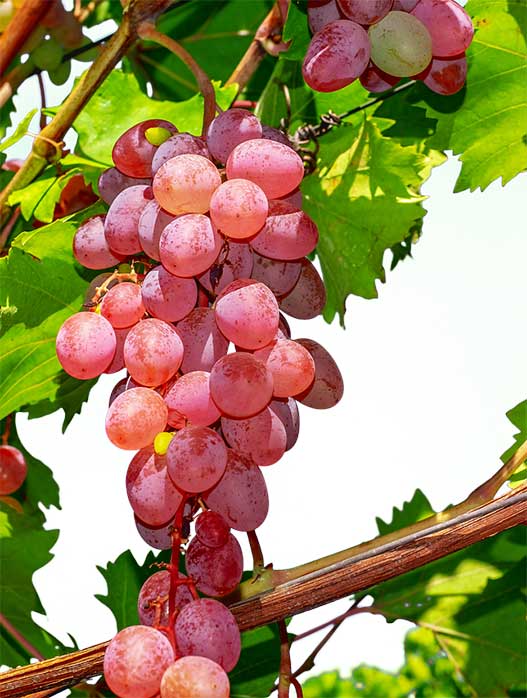fruit trees, plants and vines
Grow your own fruit
Season opens from mid April – some fruit trees listed here might not be available when you visit the nursery.
We offer a delivery and planting service for trees and evergreens – Contact Us for details.
To easily navigate this page: click on a common name below for direct scrolling.
actinidia arguta ‘prolific’
Hardy Kiwi
Hardy kiwi has large grape like vines that will need to be supported. This rapidly growing vine can spread between 10 and 20 feet per season and can quickly cover an arbor or a pergola. They also look great over a trellised gazebo. Self fertilizing.
Fruits will reach full size by mid-season and will fully ripen late in the growing season.
Height: 12′ – 20′
Width: 3′ – 5′
Exposure: Full sun to partial sun.
Watering and soil: Medium moist, well drained soil – loam or sand. Water well while establishing. They will perform best in slightly acidic soil.
Fertilizer: Use a well balanced acidic fertilizer or slow release formula.
Pruning: Prune in summer to keep in shape. For winter pruning, cut each stem back to 3 or 4 buds above the last fruited stems as flowers and fruits form on the prior seasons growth.
malus domestica ‘braeburn’
Semi Dwarf Apple
This semi dwarf apple is a popular culinary and dessert variety. It starts the season with an explosion of fragrant, pure white flowers attracting busy pollinators. Later, the flowers give way to crisp yellow green apples – a perfect blend of tartness and sweetness. This grafted fruit tree cultivar grows to a height of about 12 to 15 feet.
Although this cultivar is self-fruitful, it will produce a better crop if cross pollinated with another variety with the same bloom period. Honeycrisp, Macintosh, Granny Smith, and Fuji would work well.
Height: 12′ – 15′
Width: 12′ – 15′
Exposure: Full sun.
Watering and soil: Moist, well drained soil – loam, clay or sand. Water well while establishing.
Fertilizer: Use a well balanced fruit formula.
Pruning: Prune every season to for an optimal crop. Best practice is to make sure a lot of sunlight and airflow reaches each branch.
malus domestica ‘cortland’
Semi Dwarf Apple
This cultivar has a spectacular profusion of fragrant, pure white flowers mid spring. They attract birds and pollinators. If the trees have been pruned correctly, by fall you can expect a heavy crop of yellow green apples. The apples are tender, tart and sweet. Perfect for eating, snacking, and using in salads. This grafted fruit tree cultivar grows to a height of about 12 to 15 feet.
Although this cultivar is self-fruitful, it will produce a better crop if cross pollinated with another variety with the same bloom period. Granny Smith, and Braeburn would work well.
Height: 12′ – 15′
Width: 12′ – 15′
Exposure: Full sun.
Watering and soil: Moist, well drained soil – loam, clay or sand. Water well while establishing.
Fertilizer: Use a well balanced fruit formula.
Pruning: Prune every season to for an optimal crop. Best practice is to make sure a lot of sunlight and airflow reaches each branch.
malus domestica ‘Fuji’
Semi Dwarf Apple
Originating from Japan, this culinary cultivar resulted from a crossbreeding between the American apple varieties Red Delicious and Ralls Janet. Its pure white flowers bloom in late mid-season, adorning the branches and attracting bees, butterflies, and hummingbirds.
Come fall, the tree bears a heavy crop of medium-sized apples with a striking orange-red blush. These apples are sweet, crisp, and juicy, striking a harmonious balance between tartness and sweetness. When stored in a refrigerator, they remain fresh for up to 12 months.
Although this cultivar is self-fruitful, it will produce a better crop if cross pollinated with another variety with the same bloom period. Granny Smith, and Braeburn would work well.
Height: 12′ – 15′
Width: 12′ – 15′
Exposure: Full sun.
Watering and soil: Moist, well drained soil – loam, clay or sand. Water well while establishing.
Fertilizer: Use a well balanced fruit formula.
Pruning: Prune every season to for an optimal crop. Best practice is to make sure a lot of sunlight and airflow reaches each branch.
malus domestica ‘gala’
Semi Dwarf Apple
This grafted fruit tree cultivar grows to a height of about 12 to 15 feet. Although this cultivar is self-fruitful, it will produce a better crop if cross pollinated with another variety with the same bloom period – use Honeycrisp, Golden, Fuji, or Red Delicious.
Height: 12′ – 15′
Width: 12′ – 15′
Exposure: Full sun.
Watering and soil: Moist, well drained soil – loam, clay or sand. Water well while establishing.
Fertilizer: Use a well balanced fruit formula.
Pruning: Prune every season to for an optimal crop. Best practice is to make sure a lot of sunlight and airflow reaches each branch.
malus domestica ‘granny smith’
Semi Dwarf Apple
Granny Smith is a well-loved and popular bright skin cultivar. These fruit trees have prolific pinkish white flowers in mid spring. The fruit is firm, crisp, and juicy with a tart and acidic flavor. They are excellent for eating, baking, making sauces and can be stored up to six months.
This grafted fruit tree cultivar grows to a height of about 12 to 15 feet. Although this cultivar is self-fruitful, it will produce a better crop if cross pollinated with another variety with the same bloom period – use Golden Delicious or Red Delicious.
Height: 12′ – 15′
Width: 12′ – 15′
Exposure: Full sun.
Watering and soil: Moist, well drained soil – loam, clay or sand. Water well while establishing.
Fertilizer: Use a well balanced fruit formula.
Pruning: Prune every season to for an optimal crop. Best practice is to make sure a lot of sunlight and airflow reaches each branch.
malus domestica ‘honeycrisp’
Semi Dwarf Apple
Honeycrisp is a very popular cold hardy cultivar developed in Minnesota. They have a profusion of pure white flowers in mid spring. The apples are medium to large. The fruit has a mottled red over yellow color. The apples can last up to three months if kept in a refrigerator. They are delicious for eating and baking. They make a beautiful addition to the landscape, especially when they’re old.
This grafted fruit tree cultivar grows to a height of about 12 to 15 feet. Although this cultivar is self-fruitful, it will produce a better crop if cross pollinated with another variety with the same bloom period – use Braeburn, Gala or Red Delicious.
Height: 12′ – 15′
Width: 12′ – 15′
Exposure: Full sun.
Watering and soil: Moist, well drained soil – loam, clay or sand. Water well while establishing.
Fertilizer: Use a well balanced fruit formula.
Pruning: Prune every season to for an optimal crop. Best practice is to make sure a lot of sunlight and airflow reaches each branch.
malus ‘jonathan’
Semi Dwarf Apple
These apples are typically small to medium-sized, with skin color ranging from slightly striped to a vibrant red with a yellow background. The flesh offers a pleasant tartness, making it suitable for both fresh consumption and cooking. In northern Illinois, Jonathan apples ripen in late September to early October.
Jonathan apples thrive in full sun and require a well-drained site. They grow to a manageable height of 10-12 feet with a spread of 10 feet. These trees exhibit a slow growth, which imparts a semi-dwarf and free-standing form. They are particularly well-suited for cooking and as pie apples. Wildlife, including deer and various small mammals, appreciates Jonathan apple trees.
Height: 10′ – 12′
Width: 8′ – 10′
Exposure: Full sun.
Watering and soil: Moist, well drained soil – loam, clay or sand. Water well while establishing.
Fertilizer: Use a well balanced fruit formula.
Pruning: Prune every season to for an optimal crop. Best practice is to make sure a lot of sunlight and airflow reaches each branch.
malus domestica ‘pink lady’
Semi Dwarf Apple
This grafted fruit tree cultivar grows to a height of about 12 to 15 feet. This tree will require pollination by another variety with the same bloom period. Use Cortland, Empire or Braeburn. Pink Lady is well suited to long, hot summers.
Height: 12′ – 15′
Width: 12′ – 15′
Exposure: Full sun.
Watering and soil: Moist, well drained soil – loam, clay or sand. Water well while establishing.
Fertilizer: Use a well balanced fruit formula.
Pruning: Prune every season to for an optimal crop. Best practice is to make sure a lot of sunlight and airflow reaches each branch.
prunus armeniaca ‘blenheim’
Blenheim Apricot
Apricot Blenheim is a small to medium size fruit tree growing to about 20 feet at maturity. In early spring, there is a profusion of pinkish white flowers followed by large pale orange fruits by midsummer. The fruits are delicious for eating, baking, canning, or drying.
This tree is self-pollinating and forms a rounded crown with upright growing branches. Don’t expect a substantial harvest before 3 to 5 years.
Height: 10′ – 20′
Width: 10′ – 15′
Exposure: Full sun is best.
Watering and soil: Medium, well drained soil – loam or sand. Water well while establishing.
Fertilizer: Use a well balanced fertilizer or slow release formula.
Pruning: Prune these fruit trees regularly to shape and keep tidy after flowering. Remove crossed and rubbing branches. Cut back damaged, diseased and dead limbs.
Prune back about a third of annual growth yearly while the plant is dormant.
prunus armeniaca ’tilton’
Tilton Apricot
Apricot Tilton is a small to medium size fruit tree growing to about 25 feet at maturity. In early spring, there is a profusion of pink flowers followed by small to medium sized pale orange fruits by midsummer. The fruits are delicious for eating, baking, canning, or drying.
This tree is self-pollinating and forms a rounded crown with upright growing branches. Don’t expect a substantial harvest before 3 to 5 years.
Height: 15′ – 25′
Width: 15′ – 25′
Exposure: Full sun is best.
Watering and soil: Medium, well drained soil – loam or sand. Water well while establishing.
Fertilizer: Use a well balanced fertilizer or slow release formula.
Pruning: Prune these fruit trees regularly to shape and keep tidy after flowering. Remove crossed and rubbing branches. Cut back damaged, diseased and dead limbs.
Prune back about a third of annual growth yearly while the plant is dormant.
prunus armeniaca ‘wenatchee’
Wenatchee Apricot
Apricot Wenatchee is a small to medium size fruit tree growing to about 30 feet at maturity. In early spring there is a profusion of flowers followed by medium sized orange fruits by midsummer. The fruits are delicious for eating, baking, canning, or drying.
This tree is self-pollinating and forms a rounded crown with upright growing branches. Don’t expect a substantial harvest before 3 to 5 years.
Height: 15′ – 35′
Width: 15′ – 25′
Exposure: Full sun is best.
Watering and soil: Medium, well drained soil – loam or sand. Water well while establishing.
Fertilizer: Use a well balanced fertilizer or slow release formula.
Pruning: Prune these fruit trees regularly to shape and keep tidy after flowering. Remove crossed and rubbing branches. Cut back damaged, diseased and dead limbs.
Prune back about a third of annual growth yearly while the plant is dormant.
prunus avium ‘bing cherry’
Dwarf Bing Cherry
The cherry Bing Dwarf only grows to a height of about 10 to 15 feet. Despite that, this little tree produces an abundance of fruit. Another advantage is that they bear fruit earlier than standard cherry trees. Bing cherries are famous for their sweet and juicy taste.
Please note that these trees are not self-pollinating. You will have to have a compatible tree nearby. The Black Tartarian Cherry is recommended for this – Rainier, Lapins, Stella and Montmorency will also work.It will take three to four years before they produce fruit.
Height: 12′ – 15′
Width: 10′ – 15′
Exposure: Full sun is best.
Watering and soil: Moist, well drained soil – loam or sand. Water well while establishing, thereafter drought tolerant.
Fertilizer: Use a well balanced fertilizer or slow release formula.
Pruning: Prune these fruit trees as needed to shape and keep tidy after flowering. Remove crossed and rubbing branches. Cut back damaged, diseased and dead limbs.
prunus avium ‘black tartarian’
Black Tartarian Cherry
Cherry Black Tartarian is one of the best cultivars to pollinate other sweet cherries. This pyramidal cherry tree grows to a mature height of about 30 feet. The abundance of white, sweetly scented flowers in spring give way to a heavy crop of heart shaped sweet, dark red cherries in early summer.
This cultivar would require cross pollination with another variety such as Bing, Stellar, Rainier. It will take three to four years before they produce fruit.
Height: 12′ – 30′
Width: 12′ – 30′
Exposure: Full sun is best.
Watering and soil: Moist, well drained soil – loam or sand. Water well while establishing, thereafter drought tolerant.
Fertilizer: Use a well balanced fertilizer or slow release formula.
Pruning: Prune these fruit trees as needed to shape and keep tidy after flowering. Remove crossed and rubbing branches. Cut back damaged, diseased and dead limbs.
prunus avium ‘lapins’
‘Lapins’ Dwarf Cherry
Lapins semi dwarf cherry is a self-pollinating cultivar. It flowers prolifically in spring with pinkish white clusters. These are followed by a heavy crop of dark cherries in early midsummer. They have a sweet, rich flavor. Although Lapins does not require a pollinator, it is a good pollinator for other varieties.
Height: 12′ – 18′
Width: 12′ – 15′
Exposure: Full sun is best.
Watering and soil: Moist, well drained soil – loam or sand. Water well while establishing, thereafter fairly drought tolerant.
Fertilizer: Use a well balanced fertilizer or slow release formula.
Pruning: Prune these fruit trees as needed to shape and keep tidy after flowering. Remove crossed and rubbing branches. Cut back damaged, diseased and dead limbs.
prunus avium ‘ranier’
‘Rainer’ Yellow Cherry
Rainier is an excellent yellow cherry tree cultivar. It is a large tree growing to about 30 feet at maturity. It has a vigorous, pyramidal growing habit. The mid-spring abundance of sweetly scented flowers are followed by a healthy crop of large golden yellow cherries. The fruit has a high sugar content and are excellent for eating, preserving, and canning.
Rainier does require cross pollination – use Bing or Stella to get the best yield.
Height: 20′ – 30′
Width: 20′ – 30′
Exposure: Full sun is best.
Watering and soil: Moist, well drained soil – loam or sand. Water well while establishing, thereafter fairly drought tolerant.
Fertilizer: Use a well balanced fertilizer or slow release formula.
Pruning: Prune these fruit trees as needed to shape and keep tidy after flowering. Remove crossed and rubbing branches. Cut back damaged, diseased and dead limbs.
prunus avium ‘stella’
‘Stella’ Dark Red Cherry
Stella is a medium sized sweet dark red cherry tree cultivar. The tree produces an abundance of sweet-scented white flowers in mid spring followed by heart shaped dark cherries in early to midsummer. Their sweet, rich flavor make them excellent for eating fresh, canning, and preserving. This is a very popular, award-winning, cultivar.
A great feature of Stella is that although it is self-fertile and self-pollinating, it makes an excellent pollinator for almost any other variety.
Height: 15′ – 20′
Width: 15′ – 20′
Exposure: Full sun is best.
Watering and soil: Moist, well drained soil – loam or sand. Water well while establishing, thereafter fairly drought tolerant.
Fertilizer: Use a well balanced fertilizer or slow release formula.
Pruning: Prune these fruit trees as needed to shape and keep tidy after flowering. Remove crossed and rubbing branches. Cut back damaged, diseased and dead limbs.
prunus cerasus ‘montmorency’
‘Montmorency’ Tart Cherry
Montmorency is a popular sour cherry cultivar. It grows to a mature height of about 18 feet and has a rounded, upright habit. It has an abundance of white flowers in mid spring followed by a heavy crop of medium, large bright red cherries which have a rich, tangy sour flavor.
These cherry trees do not require a pollinator though they will yield a higher crop if cross pollination occurs.
Height: 12′ – 18′
Width: 15′ – 20′
Exposure: Full sun is best.
Watering and soil: Moist, well drained soil – loam or sand. Water well while establishing, thereafter drought tolerant.
Fertilizer: Use a well balanced fertilizer or slow release formula.
Pruning: Prune these fruit trees as needed to shape and keep tidy after flowering. Remove crossed and rubbing branches. Cut back damaged, diseased and dead limbs.
prunus cerasus ‘north star’
‘North Star’ Tart Cherry
North Star is a dwarf, cold hardy cherry tree growing to a mature height of about 10 feet. Its small size makes it ideal for small yards and gardens. Their late spring abundance of showy white flowers are followed by a heavy crop of light red tart cherries. The cherries are great for pies and sauces.
These cherry trees do not require a pollinator, though they will yield a higher crop if cross pollination occurs.
Height: 8′ – 10′
Width: 6′ – 8′
Exposure: Full sun is best.
Watering and soil: Moist, well drained soil – loam or sand. Water well while establishing, thereafter drought tolerant.
Fertilizer: Use a well balanced fertilizer or slow release formula.
Pruning: Prune these fruit trees as needed to shape and keep tidy after flowering. Remove crossed and rubbing branches. Cut back damaged, diseased and dead limbs.
prunus fruiticosa ‘wowza’
Wowza! Dwarf Cherry
Wowza is a dwarf cherry tree growing about 5 to 8 feet tall, making picking and harvesting easy. These prolific fruit trees have huge cherries with an excellent flesh to pit ratio. Each tree can yield about 20 pounds of fruit at maturity – It takes at least three years to get fruit.
They can also be grown in patio containers. They have an abundance of small white flowers in spring and are extremely cold hardy (good for zones 2 – 7). They are self-pollinating.
Height: 5′ – 8′
Width: 5′ – 7′
Exposure: Full sun is best.
Watering and soil: Moist, well drained soil – loam or sand. Water well while establishing, thereafter drought tolerant.
Fertilizer: Use a well balanced fertilizer or slow release formula.
Pruning: Prune these fruit trees as needed to shape and keep tidy after flowering. Remove crossed and rubbing branches. Cut back damaged, diseased and dead limbs.
prunus tomentosa
Nanking Cherry
Nanking Cherry is a deciduous shrub growing to about 10 feet at maturity. It has stunning white flowers, which start as pink buds. These go on to produce a profusion of edible sweet and tart fruits which ripen in early midsummer. They are perfect for jam, jellies, and pies, and of course birds love them too.
These hardy fruit trees variety adapt well to cold winters, hot summers, and drought. For cross pollination, be sure to plant more than one Nanking.
Height: 6′ – 8′
Width: 6′ – 8′
Exposure: Full sun is best.
Watering and soil: Moist, well drained soil – loam or sand. Water well while establishing, thereafter drought tolerant.
Fertilizer: Use a well balanced fertilizer or slow release formula.
Pruning: Pruning as needed to shape and keep tidy after flowering. Remove crossed and rubbing branches.
prunus persica ‘contender’
Contender Peach
Persica is a low growing, broad shaped peach tree. While they have the shorter lifespan of about 10 to 20 years, they make a statement in the orchard or garden. From the showy spring flowers ranging in color from pure white to deep red, through to their large shaped dark green leaves and spectacular yellow, orange, fall colors, these trees are well worth growing. Persica has freestone fruit (flesh does not bind to the pit).
Peach and nectarine trees are self-fertile and do not need pollinators. The only difference between a peach and nectarine is a single gene mutation that regulates the fuzzy skin coating.
Height: 10′ – 15′
Width: 10′ – 15′
Exposure: Full sun is best.
Watering and soil: Moist, well drained soil, loam or sand. Water well while establishing.
Fertilizer: Use a well balanced fertilizer or slow release formula.
Pruning: Peaches do require annual pruning to keep them healthy, strong, and bountiful. They are excellent fruit trees for espalier training too. To receive maximum sunlight and good air circulation, train these trees to an open center shape. Be sure to remove all rootstock suckers, dead and non-fruiting wood.
prunus persica ‘elberta’
Elberta Peach
Elberta is an heirloom variety and one of the most popular peach trees. These freestone peaches are prolific producers and can yield as much as 150 pounds of sweet and juicy fruit every year. The branches are adorned with fragrant pink blossoms in early to mid-spring. In fall, the leaves turn a deep yellow.
Alberta is a self-pollinating tree forming a rounded crown. It grows to about 14 feet at maturity.
Height: 10′ – 14′
Width: 8′ – 12′
Exposure: Full sun is best.
Watering and soil: Moist, well drained soil, loam or sand. Water well while establishing.
Fertilizer: Use a well balanced fertilizer or slow release formula.
Pruning: Peaches do require annual pruning to keep them healthy, strong, and bountiful. They are excellent fruit trees for espalier training too. To receive maximum sunlight and good air circulation, train these trees to an open center shape. Be sure to remove all rootstock suckers, dead and non-fruiting wood.
prunus persica ‘redhaven’
Redhaven Peach
Redhaven is a fast-growing peach tree reaching a mature height of about 15 feet. They have beautiful pink blossoms in mid spring, followed by a heavy crop of freestone, medium sized yellow red fruits. The leaves turn deep yellow in fall.
Redhaven is a self-pollinating tree forming a rounded crown.
Height: 12′ – 15′
Width: 12′ – 15′
Exposure: Full sun is best.
Watering and soil: Moist, well drained soil, loam or sand. Water well while establishing.
Fertilizer: Use a well balanced fertilizer or slow release formula.
Pruning: Peaches do require annual pruning to keep them healthy, strong, and bountiful. They are excellent fruit trees for espalier training too. To receive maximum sunlight and good air circulation, train these trees to an open center shape. Be sure to remove all rootstock suckers, dead and non-fruiting wood.
prunus persica ‘reliance’
Reliance Peach
Reliance is a hardy, late season, sweet fruit producing peach tree. It has beautiful spring flowers – a vigorous grower and produces a bumper crop of peaches. The fruit is freestone. Excellent for eating, canning, and freezing. Although they grow to mature height of about 15 feet, you can prune them back to a height of eight feet for easier harvesting.
Reliance is a self-pollinating tree forming a rounded crown.
Height: 12′ – 15′
Width: 12′ – 15′
Exposure: Full sun is best.
Watering and soil: Moist, well drained soil – loam or sand. Water well while establishing.
Fertilizer: Use a well balanced fertilizer or slow release formula.
Pruning: Peaches do require annual pruning to keep them healthy, strong, and bountiful. They are excellent fruit trees for espalier training too. To receive maximum sunlight and good air circulation, train these trees to an open center shape. Be sure to remove all rootstock suckers, dead and non-fruiting wood.
pyrus communis ‘Bartlett’
Bartlett
Bartlett pear is another favorite heirloom cultivar. By mid-spring they burst to life with a profusion of fragrant, creamy white flowers. This show is followed by a heavy crop of medium to large thin skinned yellow pears. The fruit is juicy, sweet, and tender. Perfect for eating, canning and preserves.
Bartlett is partially self-pollinating and will produce the largest yields if cross pollinated with Moonglow or Orient cultivars which have the same blooming period.
Height: 12′ – 20′
Width: 8′ – 20′
Exposure: Full sun is best.
Watering and soil: Moist, well drained soil – loam or sand. Water well while establishing.
Fertilizer: Use a well balanced fertilizer or slow release formula.
Pruning: Pear require annual pruning to keep them healthy, strong, and bountiful. They are excellent fruit trees for espalier training too. To receive maximum sunlight and good air circulation, train these trees to an open center shape.
pyrus communis ‘D’Anjou’
D’Anjou Pear
D’Anjou has been a favorite pear variety for many years. It has an aromatic flesh and citrus-like sweet flavor. Expect beautiful, creamy white flowers in mid spring that attract pollinators. These trees produce a heavy crop – the fruit is a lime green color and triangular shape. These pears are perfect for eating, cooking, baking, and making cider.
D’Anjou is partially self-pollinating and grows to a mature height of 10 to 15 feet. For the largest yields, though, it is recommended to cross pollinate with Bosc, Bartlett or Comice.
Height: 10′ – 15′
Width: 10′ – 15′
Exposure: Full sun is best.
Watering and soil: Moist, well drained soil – loam or sand. Water well while establishing.
Fertilizer: Use a well balanced fertilizer or slow release formula.
Pruning: Pear require annual pruning to keep them healthy, strong, and bountiful. They are excellent fruit trees for espalier training too. To receive maximum sunlight and good air circulation, train these trees to an open center shape.
pyrus communis ‘Moonglow’
Moonglow Pear
Moonglow is a heavy producing cultivar. From mid spring, the have a profusion of fragrant, creamy white flowers followed by a bountiful crop of heavy large pears in late summer. The fruit has a yellow skin with a red blush. They are excellent for eating, canning and preserves. Like all pear trees, they are an excellent addition to the landscape.
Moonglow is not a self-pollinating variety and will require pollination with another variety with the same bloom period, such as Bartlett or Orient.
Height: 12′ – 20′
Width: 8′ – 12′
Exposure: Full sun is best.
Watering and soil: Moist, well drained soil – loam or sand. Water well while establishing.
Fertilizer: Use a well balanced fertilizer or slow release formula.
Pruning: Pear require annual pruning to keep them healthy, strong, and bountiful. They are excellent fruit trees for espalier training too. To receive maximum sunlight and good air circulation, train these trees to an open center shape.
pyrus communis ‘Seckel’
Seckel Pear
Seckel is a partially self-fertile pear. It will produce much higher yields if pollinated with Bartlett, Bosc, or Comice which bloom at the same time.
Height: 10′ – 15′
Width: 8′ – 12′
Exposure: Full sun is best.
Watering and soil: Moist, well drained soil – loam or sand. Water well while establishing.
Fertilizer: Use a well balanced fertilizer or slow release formula.
Pruning: Pear require annual pruning to keep them healthy, strong, and bountiful. They are excellent fruit trees for espalier training too. To receive maximum sunlight and good air circulation, train these trees to an open center shape.
prunus cerasifera ‘frankthrees’
Mount St. Helens Plum Tree
Mount Saint Helens plum has a straight growing trunk with vigorous early spring growth. The leaves are a rich purple in color and the flowers are light pink. The tree will reach about 20 feet at maturity – its rounded characteristic will give it a similar width.
This tree is essentially known for its aesthetic beauty and will produce plums midsummer.
Height: 10′ – 20′
Width: 10′ – 20′
Exposure: Full sun.
Watering and soil: Moist, well drained rich soil. Apply an even layer of mulch over the soil avoiding it piling up the trunk in ‘volcano’ fashion.
Fertilizer: Use a well balanced fertilizer or slow release formula.
Pruning: It is especially important to train plum trees when young. With careful pruning at their early stages, they will require only light maintenance pruning as they mature.
Image: AnRo0002, CC0, via Wikimedia Commons
prunus domestica
Dwarf Italian Plum
Italian plum has a medium sized purplish black fruit. They are great to eat fresh or used for canning or drying. Their high sugar content makes them possible to sun dry without pitting.
Expect the first crop of plums about five years after planting. These fruit trees are self-fertile.
Height: 15′ – 20′
Width: 15′ – 30′
Exposure: Full sun.
Watering and soil: Moist, well drained rich soil. Apply an even layer of mulch over the soil avoiding it piling up the trunk in ‘volcano’ fashion.
Fertilizer: Use a well balanced fertilizer or slow release formula.
Pruning: It is especially important to train plum trees when young. With careful pruning at their early stages, they will require only light maintenance pruning as they mature.
When the tree is about two years old reduce to three or four well-spaced branches to maintain an open sun filled structure. Good air circulation around the branches is particularly important.
prunus salicina ‘Methley’
Dwarf Japanese Plum
These trees are self-pollinating, however they can be pollinated with other varieties.
Height: 8′ – 10′
Width: 8′ -130′
Exposure: Full sun.
Watering and soil: Moist, well drained rich soil. Apply an even layer of mulch over the soil avoiding it piling up the trunk in ‘volcano’ fashion.
Fertilizer: Use a well balanced fertilizer or slow release formula.
Pruning: It is especially important to train plum trees when young. With careful pruning at their early stages, they will require only light maintenance pruning as they mature.
When the tree is about two years old reduce to three or four well-spaced branches to maintain an open sun filled structure. Good air circulation around the branches is particularly important.
prunus toka
Toka Plum Hybrid
Toka plum is a hybrid cross between the American Plum (Prunus americana) and Japanese plum (Prunus salicina). This upright vase shaped plum tree is an excellent pollinator – the fragrant white petaled blooms produce a lot of pollen each season. This is followed by a good yield of medium sized purple red plums.
Toka is a self-pollinating hybrid that can be paired with a pollinating plum to increase the yield.
Height: 15′ – 20′
Width: 15′ – 20′
Exposure: Full sun.
Watering and soil: Moist, well drained rich soil. Apply an even layer of mulch over the soil avoiding it piling up the trunk in ‘volcano’ fashion.
Fertilizer: Use a well balanced fertilizer or slow release formula.
Pruning: It is especially important to train plum trees when young. With careful pruning at their early stages, they will require only light maintenance pruning as they mature.
When the tree is about two years old reduce to three or four well-spaced branches to maintain an open sun filled structure. Good air circulation around the branches is particularly important.
ribes rubrum ‘blanka’
White Currant
Blanka is a deciduous currant variety growing to about 5 feet at maturity. It would take five years or more to reach this height. They have lobed, toothed, mid-green leaves.
These fruit trees form clusters of insignificant yellow green flowers in spring. These are followed by glossy translucent, ivory to pale apricot edible fruits ready for harvest in late summer.
Height: 3′ – 5′
Width: 3′ – 5′
Exposure: Full sun to partial shade.
Watering and soil: Moist, well drained rich soil. Apply an even layer of mulch over the soil avoiding it piling up the trunk in ‘volcano’ fashion.
Fertilizer: Use a well balanced fertilizer or slow release formula.
Pruning: Pruning as needed to shape and keep tidy. Remove crossed and rubbing branches.
rubus idaeus ‘fallgold’
Raspberry Fallgold – Yellow Raspberry
Fallgold is a deciduous self-pollinating raspberry. They have the same delicious taste as the sweet red varieties. This variety is a primocane berry, that is, it blooms and fruits on first year wood allowing us to have two harvests in the season. If you want a single heavier crop, all canes can be pruned annually to the ground before growth begins in spring.
The fruits are great eaten fresh or used for preserves and pies.
Height: 4′ -5′
Width: 2′ – 3′
Exposure: Full sun to partial shade.
Watering and soil: Moist, well drained rich soil. A slightly acidic organically rich mix is best.
Fertilizer: Use a well balanced fertilizer or slow release formula.
Pruning: Pruning as needed to determine harvest.
rubus idaeus ‘heritage’
Red Raspberry Heritage
Heritage is one of the most popular raspberry cultivars worldwide. It’s an upright, thorny shrub producing two crops on each cane; a smaller crop in early summer, followed by a heavy crop in the fall. Their spring rose-like white flowers produce an abundance of raspberries. They’re great eating fresh, freezing, canning and used as preservatives.
Height: 5′ – 6′
Width: 3′ – 4′
Exposure: Full sun to partial shade (will produce less fruit).
Watering and soil: Moist, well drained organically rich soil. A slightly acidic mix is best. Do not let them get waterlogged.
Fertilizer: Use a well balanced fertilizer or slow release formula.
Pruning: Prune in summer after fruiting. Cut back about 1/3 and leave the rest of the canes for late summer fruiting. Then remove the canes to encourage the production of new ones. Remove suckers to control spread.
rubus idaeus ‘munger’
Raspberry Munger Black
Height: 4′ – 5′
Width: 3′ – 4′
Exposure: Full sun to partial shade (will produce less fruit).
Watering and soil: Moist, well drained organically rich soil. A slightly acidic mix is best. Do not let them get waterlogged.
Fertilizer: Use a well balanced fertilizer or slow release formula.
Pruning: Prune in summer after fruiting. Cut back about 1/3 and leave the rest of the canes for late summer fruiting. Then remove the canes to encourage the production of new ones. Remove suckers to control spread.
rubus ‘latham’
Latham Raspberry Bush
Raspberry Latham, also known as Summer Bearing Raspberry, sets berries mid-summer after their white rose like flowers give way. The fruit is medium size.
This variety comes from Minnesota and is exceptionally cold hardy (zones 3 – 8). It’s narrow spread of only 1 to 2 feet is perfect for containers and small gardens.
Height: 4′ -5′
Width: 1′ – 2′
Exposure: Full sun to partial shade (will produce less fruit).
Watering and soil: Moist, well drained organically rich soil. A slightly acidic mix is best. Do not let them get waterlogged.
Fertilizer: Use a well balanced fertilizer or slow release formula.
Pruning: Prune in summer after fruiting. Cut back about 1/3 and leave the rest of the canes for late summer fruiting. Then remove the canes to encourage the production of new ones. Remove suckers to control spread.
rubus ‘royalty’
Raspberry Royalty
Raspberry Royalty is a cross between black and red raspberries. Producing large fruit, they are excellent for fresh eating, cooking, and baking. They have the sweet taste.
They are open multi stem deciduous shrubs with an upright spreading habit. Like all raspberries, they do require regular care and upkeep.
Height: 5′ -6′
Width: 3′ – 4′
Exposure: Full sun to partial shade (will produce less fruit).
Watering and soil: Moist, well drained organically rich soil. A slightly acidic mix is best. Do not let them get waterlogged.
Fertilizer: Use a well balanced fertilizer or slow release formula.
Pruning: Prune in summer after fruiting. Cut back about 1/3 and leave the rest of the canes for late summer fruiting. Then remove the canes to encourage the production of new ones. Remove suckers to control spread.
vaccinium corybosum ‘bluecrop’
Blueberry Bluecrop
This variety of blueberry is a bushy, upright deciduous shrub growing to about 6 to 8 feet. Creamy white flower clusters produce light blue berries, which ripen in midsummer. The fruit is great for preserves, baking, freezing, or eating fresh. Birds and wildlife love them too. Blueberries do best if they are cross pollinated with more than one variety that has the same bloom time.
It is important to plant blueberries in an acidic soil with a pH of between 4 and 5. They will not perform well with a high pH.
Height: 6′ -8′
Width: 6′ – 8′
Exposure: Full sun is best.
Watering and soil: Moist, well drained acidic soil is essential. To lower your soil PH to 4 and 5 use regular sulfur applications working the granules into the soil. Ideally, do this three months before new planting.
Fertilizer: Use a well balanced fertilizer or slow release formula.
Pruning: Start pruning after the third year in late winter or very early spring.
vaccinium corybosum ‘elliot’
Blueberry Elliot
Blueberry Elliot is a multi-stemmed variety with a rounded habit. Following flowering, they produce prolific amounts of delicious edible black berries. Birds love them too! Pollinators are attracted to them when in flower. This variety has interest throughout the seasons making them ideal garden plants.
This is an excellent fruit variety for hedges or shrub borders.
Height: 4′ – 6′
Width: 4′ – 6′
Exposure: Full sun is best.
Watering and soil: Moist, well drained acidic soil is essential. To lower your soil PH to 4 and 5 use regular sulfur applications working the granules into the soil. Ideally, do this three months before new planting.
Fertilizer: Use a well balanced fertilizer or slow release formula.
Pruning: Start pruning after the third year in late winter or very early spring.
vaccinium corybosum ‘northland’
Blueberry Northland
Blueberry Northland is especially noted for its cold hardiness (zones 3 – 7) making it a good fruiting plant for beds and containers. This variety has a compact, rounded dense shape only growing to about 4 feet tall with a wider spread. The berries are sweet and ripen in early summer.
Height: 4‘ – 6’
Width: 4′ – 5′
Exposure: Full sun is best.
Watering and soil: Moist, well drained acidic soil is essential. To lower your soil PH to 4 and 5 use regular sulfur applications working the granules into the soil. Ideally, do this three months before new planting.
Fertilizer: Use a well balanced fertilizer or slow release formula.
Pruning: Start pruning after the third year in late winter or very early spring.
vitus labrusca ‘reliance’
Fox Grape
Reliance is a cold hardy (zones 4 – 7), vigorous seedless grape variety producing medium sized clusters of glossy red grapes early in the season. These are excellent eating grapes with a firm texture and sweet taste. This vine is self-pollinating and has good resistance to pests and disease.
They are easy to grow and look great decoratively covering fences and trellises. Grapevines need arbors, pergolas, walls or fences that offers sturdy support for their twining stems.
Height: 15′ – 20′
Width: 15′ – 20′
Exposure: Full sun.
Watering and soil: Moist, well drained soil is essential. It can tolerate a wide range of soil type from sand to clay. Needs good air circulation.
Fertilizer: Use a well balanced fertilizer or slow release formula.
Pruning: Start pruning after the third year in late winter or very early spring.


